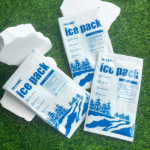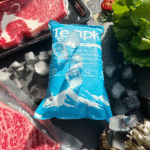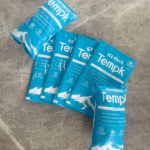Mengirimkan makanan beku tidak semudah memasukkan es ke dalam kotak. Untuk menjaga kualitas dan keamanan, Anda memerlukan metode pendinginan yang tepat. A Paket es kering untuk pengiriman barang beku menjaga produk pada suhu di bawah −10 °C dengan melakukan sublimasi dari karbon dioksida padat menjadi gas. Panduan ini membantu Anda memilih dan menggunakan paket es kering secara efektif, menggambar 2025 regulasi dan inovasi terkini. Pada akhirnya, Anda akan tahu cara mengukur ukuran paket, kemas kotak dengan benar dan ikuti aturan operator.

Cara kerja kantong es kering dan mengapa kantong tersebut lebih baik dibandingkan kantong es gel untuk barang beku.
Berapa banyak es kering yang Anda perlukan untuk ukuran dan rute kotak yang berbeda.
Petunjuk langkah demi langkah untuk mengemas dan menangani es kering dengan aman.
Perbedaan antara es kering, paket gel dan bahan pengubah fase dan kapan harus menggunakannya.
2025 tren dalam paket es kering, termasuk isolasi yang lebih ramah lingkungan dan sensor cerdas.
Bagaimana Paket Es Kering Menjaga Barang Beku Aman Selama Transit?
Menjawab: Paket es kering terdiri dari karbon dioksida padat yang disimpan dalam plastik tugas berat atau penutup non-anyaman. Saat terkena udara hangat, CO₂ padat menyublim (langsung berubah menjadi gas) pada suhu sekitar −78,5 °C. Proses ini menyerap panas dari produk di sekitarnya, menjaganya di bawah titik beku. Pengirim berventilasi memungkinkan gas CO₂ keluar sementara insulasi memperlambat perolehan panas. Karena es kering tidak pernah mencair, tidak ada air yang berantakan, membuatnya ideal untuk daging beku, hidangan laut, es krim dan spesimen laboratorium.
Jalur E commerce yang dibekukan: Es kering vs.. Gel dan PCM
Tabel di bawah ini merangkum metode pendinginan mana yang paling sesuai untuk rentang suhu berbeda dan kasus penggunaan umum. Es kering menghasilkan suhu terendah dan mengungguli kemasan gel dalam hal waktu tunggu per liter, terutama saat penundaan sore yang panas. Kemasan gel lebih aman untuk barang dingin yang tidak membeku, saat bahan berubah fasa (PCMS) mempertahankan rentang tertentu dan sering kali dapat digunakan kembali.
| Metode pendinginan | Kisaran suhu | Klasifikasi Bahaya | Reusability | Kasus Penggunaan Khas |
| Paket es kering | < −70 °C | Berbahaya (Dan 1845), memerlukan pelabelan | Sekali pakai; dapat dikombinasikan dengan paket gel | Biologi yang sangat beku, es krim, daging beku |
| Paket gel | 0 ° C ke 8 ° C. | Tidak berbahaya | Sekali pakai atau penggunaan kembali terbatas | Vaksin yang tidak boleh dibekukan, cokelat, produk segar |
| Paket PCM | 2 ° C ke 8 °C atau −20 °C | Tidak berbahaya | Dapat digunakan kembali | Farmasi, uji klinis yang memerlukan kontrol yang tepat |
Tips Praktis:
Muat atas terlebih dahulu: Tempatkan kantong es kering di atas produk agar udara dingin meresap secara alami.
Ventilasi tutupnya: Jangan pernah menyegel CO₂; gunakan penutup atau celah berventilasi agar gas dapat keluar.
Kecilkan kekosongan: Minimalkan ruang kosong dengan sisipan untuk memperlambat pemanasan.
Bungkus muatannya: Pembungkus tipis mencegah embun beku dan menjaga karton tetap bersih.
Uji jalur Anda: Gunakan pencatat data berbiaya rendah untuk memvalidasi resep sebelum melakukan penskalaan.
Kasus nyata: Sebuah merek makanan laut khusus beralih ke kemasan es kering isi atas dan menambahkan a 15 % penyangga untuk penundaan akhir pekan. Tingkat klaim musim panas mereka turun dari 6.4 % ke 1.9 % melintasi tiga zona, sementara pengalaman membuka kotaknya tetap konsisten.
Fisika Dibalik Sublimasi
Keunggulan es kering terletak pada sublimasinya. Ketika CO₂ bertransisi dari padat menjadi gas, ia menyerap banyak panas—kira-kira 571 kJ/kg—tanpa meninggalkan air cair. Penyerapan ini membuat produk di sekitarnya tetap beku dan menghilangkan kelembapan, menghambat pertumbuhan bakteri. Suhu yang sangat rendah (−78,5 °C) memungkinkan waktu penahanan 24–96 jam bila dikombinasikan dengan isolasi nilai R tinggi. Untuk perdagangan elektronik, heat sink yang tinggi per liter memastikan barang tetap beku bahkan selama pengalihan rute operator atau kemacetan hub.
| Fitur | Fungsi | Keuntungan |
| Inti yang sangat dingin (−78,5 °C) | Menjaga muatan di bawah titik beku | Waktu pelestarian lebih lama; cocok untuk vaksin, biologis dan makanan beku |
| Sublimasi (tidak ada cairan) | CO₂ padat berubah menjadi gas, menyerap panas | Mengurangi kontaminasi dan kerusakan kemasan |
| Lapisan luar yang tahan lama | Bahan berlapis-lapis menahan tusukan dan mengatur pelepasan gas | Mencegah kebocoran dan menurunkan risiko kerusakan produk |
| Desain ringan | Kepadatan lebih rendah dari es air | Menghemat ruang dan biaya pengiriman; lebih banyak barang per pengiriman |
| Bentuk yang dapat disesuaikan | Blok, pelet atau lembaran muat berbagai wadah | Fleksibilitas untuk paket, palet dan peralatan klinis |
Tip dan Saran Pengguna
Pengiriman lokal singkat: Gunakan paket es kering yang bersumber secara lokal untuk pengiriman pada hari yang sama; mereka menyublim lebih lambat dan mengurangi emisi transportasi.
Hibrida berlapis: Untuk musim bahu, gabungkan 70–85 % es kering dengan PCM kecil bersuhu −10 °C untuk mencegah pembekuan berlebih.
Pantau pengiriman: Tambahkan pencatat suhu atau sensor untuk melacak kondisi secara real time.
Kasus aktual: Sebuah bisnis katering yang mengantarkan makanan pembuka beku ke seluruh kota menggunakan bungkus es kering lokal segar dengan kantong berinsulasi. Mengisi ruang kosong dengan kertas kusut dan menambahkan ~5 kg es kering menjaga kualitas dan menghindari kemasan yang basah.
Berapa Banyak Es Kering yang Anda Butuhkan untuk Pengiriman Barang Beku?
Menjawab: Jumlah es kering tergantung pada volume bagian dalam kotak, suhu lingkungan dan waktu transit. Untuk rute hangat (20–30 °C), rencana 1.1–1,5 kg es kering per 10 liter volume internal per 24 jam. Menggunakan 0.8–1,0kg untuk rute ringan (10–20 °C) Dan 1.5–1,9kg untuk rute panas (30–40 °C). Tambahkan 10–20 % buffer untuk memperhitungkan penundaan.
Metode Langkah demi Langkah untuk Memperkirakan Es Kering
Ukur volume internal: Hitung panjang × lebar × tinggi ruang terisolasi dalam liter.
Pilih jalur rute: Identifikasi apakah kiriman Anda melewati jalur ringan (10–20 °C), hangat (20–30 °C) atau panas (30–40 °C) kondisi.
Gunakan tabel tarif: Kalikan takaran kg/10 L/24 jam yang dipilih dengan volume kotak dan jumlah hari.
Tambahkan penyangga: Tingkatkan 10–20 % untuk menutupi penundaan yang tidak terduga.
Dokumentasikan beratnya: Kumpulkan dan catat kilogram bersih es kering pada label.
| Pita Rute | Profil Sekitar | kg per 10 L untuk 24 H | Apa artinya bagimu |
| Lembut | 10–20 °C | 0.8–1,0kg | Beban panas yang lebih rendah; Sublimasi yang lebih lambat |
| Hangat | 20–30 °C | 1.1–1,5kg | Rute e-commerce yang khas dan puncak sore hari |
| Panas | 30–40 °C | 1.5–1,9kg | Tinggal lama, pengiriman terkena sinar matahari dan gelombang panas |
Contoh: A 24 L pengirim pada rute hangat untuk 48 kebutuhan jam kurang lebih 7.1 kg es kering. Mulailah dengan 1.3 kg× (24 aku 10) × 2 hari = 6.2 kg; lalu tambahkan a 15 % penyangga untuk dijangkau 7.1 kg.
Tabel Referensi Kuantitas
Kuantitas es kering juga berhubungan dengan berat muatan. Tabel di bawah ini memberikan referensi mudah untuk a 10 lb (≈4,5kg) muatan:
| Durasi Pengiriman | Es Kering yang Direkomendasikan | Contoh (10 lb Muatan) | Apa artinya bagimu |
| 24 jam (semalam) | 0.5 × berat muatan | ~5 pon es kering | Ideal untuk pengiriman lokal atau layanan kurir hari berikutnya |
| 48 jam | 1 × berat muatan | ~10 pon es kering | Cocok untuk pengiriman regional atau lintas negara |
| 72 jam+ | 1.5 × berat muatan | ~15 pon es kering | Diperlukan untuk pengiriman jarak jauh atau internasional |
Penyempurnaan Tanpa Matematika yang Rumit
Perlindungan tepi: Jika ujung-ujungnya mencair sebelum inti, tambahkan potongan kecil es kering di sepanjang sisinya.
Kurangi kontak langsung: Tempatkan rak bergelombang tipis di antara es kering dan muatan untuk menghindari karton rapuh.
Resep hibrida: Di musim bahu, gunakan 70–85 % es kering ditambah ubin PCM pada suhu −10 °C untuk meredakan lonjakan suhu.
Contoh dunia nyata: Distributor makanan laut mengganti kemasan gel dengan kemasan es kering tugas berat untuk pengiriman lintas negara selama 48 jam. Menggunakan es kering dan muatan dengan berat yang sama mengurangi pembusukan 12 % ke 1 % dan disimpan $50,000 setiap tahun.
Cara Mengemas dan Menangani Paket Es Kering dengan Aman untuk Pengiriman Beku
Menjawab: Pengepakan dan penanganan yang aman meminimalkan bahaya seperti peningkatan tekanan, perpindahan oksigen dan radang dingin. SOP terstruktur memastikan pengulangan di seluruh tim Anda dan kepatuhan terhadap peraturan.
SOP Pengepakan Langkah demi Langkah
Pra-panggung kotaknya: Tempatkan bantalan bawah dan sisipan sudut untuk mengurangi sirkulasi udara.
Siapkan inti yang dibungkus: Bungkus produk dengan lapisan pelindung tipis dan hilangkan udara berlebih.
Pas di bagian samping yang ketat: Masukkan bantalan samping agar inti tidak bergerak.
Muat paketnya dari atas: Pecahkan balok es kering berukuran besar menjadi potongan-potongan kecil dan letakkan di atas inti es.
Ventilasi dan label: Gunakan tutup berventilasi dan tandai “Es Kering (Dan 1845)” dengan kilogram bersih CO₂.
Timbang dan catat: Catat berat kotornya, CO₂ bersih dan ID pengemas.
Tes goyang terakhir: Jika isinya bergerak, tambahkan dunnage ringan sampai pas.
Pedoman Kepatuhan dan Keselamatan
Penamaan yang tepat: Labeli kemasan dengan “Es Kering” atau “Karbon Dioksida, Solid” dengan berat bersih dan nomor PBB (Dan 1845).
Ventilasi: Jangan pernah menyegel CO₂; gunakan tutup berventilasi atau jalur gas.
Kompatibilitas bahan: Pilih pelapis dan perekat yang tahan terhadap suhu −78.5 °C.
Dokumentasi: Air waybill harus mencantumkan es kering dan kuantitasnya.
APD dan pelatihan: Sediakan sarung tangan dan pelatihan untuk pengepakan dan penerima.
Hindari wadah tertutup: Jangan menyimpan es kering di dalam freezer atau pendingin kedap udara untuk mencegah ledakan tekanan.
Perlengkapan pelindung: Kenakan sarung tangan terisolasi dan pelindung mata; kontak dengan es kering dapat menyebabkan radang dingin di bagian bawah 30 detik.
Daftar Periksa Penanganan yang Aman
Simpan CO₂ di tempat yang berventilasi—bukan di ruangan tertutup atau bagasi mobil.
Simpan sarung tangan termal di tempat pengepakan.
Hindari pendingin kedap udara; selalu melampiaskan tutupnya.
Instruksikan penerima untuk membuka paket di ruang berventilasi dan menghindari kontak kulit.
Berikan nomor telepon darurat pada label untuk pertanyaan selama pengiriman.
Kasus aktual: Distributor makanan laut asli mencetak catatan “Ventilasi Sebelum Dibuka” di dalam tutupnya dan menambahkan nomor telepon darurat. Langkah sederhana ini mengurangi keluhan penerima dan meningkatkan kepatuhan keselamatan.
Es kering vs.. Paket Gel vs. Bahan Perubahan Fase: Mana yang terbaik?
Barang yang berbeda memerlukan strategi pendinginan yang berbeda. Es kering menawarkan suhu terdingin, namun kemasan gel dan PCM mempunyai kelebihannya masing-masing dan seringkali tidak berbahaya.
Tabel Perbandingan dan Perbedaan Utama
| Metode pendinginan | Kontrol suhu | Bahaya & Pelabelan | Kelembaban | Dampak Lingkungan | Reusability |
| Paket es kering | Suhu sangat rendah (< −70 °C) | Berbahaya (Dan 1845); memerlukan pelabelan dan dokumentasi | Sublimat menjadi gas, meninggalkan kemasan kering | Sublimasi melepaskan CO₂; tidak ada limbah fisik | Sekali pakai; dapat dikombinasikan dengan paket gel |
| Paket gel | Menjaga barang tetap dingin di dekat Anda 0 ° C. | Tidak berbahaya | Meleleh ke dalam air; dapat menyebabkan kemasan menjadi basah | Dapat memiliki eksterior yang dapat terbiodegradasi; ada opsi yang dapat digunakan kembali | Seringkali dapat digunakan kembali atau digunakan kembali secara terbatas |
| Paket PCM | Mempertahankan rentang tertentu (MISALNYA., 2–8 °C atau −20 °C) | Tidak berbahaya | Tidak ada cairan gratis; perubahan fasa terjadi pada suhu yang disetel | Dapat digunakan kembali tinggi; beberapa PCM memiliki komponen yang dapat didaur ulang | Dapat digunakan kembali dan cocok untuk obat-obatan |
Rekomendasi
Pengiriman beku (>72 jam): Gunakan paket es kering tugas berat. Untuk jangka waktu yang lama, kombinasikan dengan paket gel untuk memperlambat sublimasi dan mempertahankan beberapa zona suhu.
Pengiriman dingin (0–8 ° C.): Pilih paket gel; mereka hemat biaya dan tidak berbahaya.
Kebutuhan dingin atau dapat digunakan kembali dalam jumlah sedang: Gunakan PCM untuk obat-obatan dan uji klinis; mereka menawarkan kontrol yang tepat dan dapat digunakan kembali.
Hindari pembekuan: Saat mengirimkan coklat atau barang lain yang tidak boleh dibekukan, hindari es kering. Gunakan kemasan gel dan kotak berinsulasi untuk menjaga suhu 4–8 °C.
Petunjuk praktis: Untuk pengiriman campuran yang berisi barang beku dan dingin, tempatkan penghalang di dalam kotak dan posisikan es kering hanya di sekitar barang beku sambil menggunakan kemasan gel untuk kompartemen dingin.
2025 Tren Kemasan Es Kering dan Pengiriman Beku
Tinjauan Tren: Logistik rantai dingin berkembang pesat. Di dalam 2025, paket es kering terus menjadi patokan beku, tapi ada pergeseran ke arah kotak yang lebih ringan dengan nilai R lebih tinggi, liner ramah tepi jalan dan aplikasi pengepakan yang lebih cerdas. Strategi PCM hibrida berkembang untuk musim sepi dan jaringan dengan pembatasan CO₂. Pasar juga melihat peningkatan pelacakan dan material yang lebih ramah lingkungan.
Sekilas Kemajuan Terbaru
Lapisan reflektif serat: Insulasi berbasis kertas dengan film reflektif mikro mempersempit kesenjangan kinerja dengan busa sekaligus meningkatkan kemampuan daur ulang.
Pencatat data mini di bawah $20: Pencatat Bluetooth atau NFC yang terjangkau membantu memvalidasi jalur pelayaran baru sebelum musim puncak.
Kiting sadar rute: Aplikasi pengepakan secara otomatis memilih yang ringan, resep hangat atau panas di stasiun berdasarkan prakiraan cuaca.
Strategi hibrida: Menggabungkan es kering dengan PCM mengurangi kelebihan penggunaan dan penggunaan CO₂.
Fokus pada keberlanjutan: Pemasok menangkap CO₂ industri untuk membuat es kering dan menawarkan eksterior paket gel yang dapat terbiodegradasi. PCM dapat digunakan kembali dan mengurangi limbah.
Wawasan pasar
Merek yang menjaga kualitas produk beku mengalami tingkat pembelian berulang yang lebih tinggi. Penurunan klaim sebesar satu poin dapat mendanai resep es kering yang lebih kuat sepanjang musim panas. Dengan menentukan ukuran kemasan yang tepat dan menyesuaikan resep secara musiman, perusahaan dapat mengurangi massa es kering sebesar 10–15 %. Solusi hibrida dapat mengurangi penggunaan CO₂ hingga ~10 % sambil menghaluskan lonjakan suhu. Ketika persaingan semakin ketat 2025, berinvestasi pada isolasi yang lebih baik dan pencatatan data akan memberikan keuntungan melalui pengembalian dana yang lebih sedikit dan loyalitas pelanggan yang lebih tinggi.
Pertanyaan yang sering diajukan
Q1: Berapa lama es kering akan membuat kiriman saya tetap beku?
A: Untuk rute hangat, rencanakan 1,1–1,5 kg es kering per 10 L untuk 24 jam; rute panas membutuhkan 1,5–1,9 kg. Ventilasi tutup dan muatan atas untuk menghindari pemanasan awal.
Q2: Apakah pengiriman udara diperbolehkan dengan es kering?
A: Ya. Tandai kemasannya “Es Kering (Dan 1845)” dengan kilogram bersih dan mengikuti aturan maskapai dan IATA. Air waybill harus menunjukkan jumlahnya, dan operator mungkin memerlukan nomor kontak.
Q3: Berapa banyak paket yang harus saya gunakan dalam a 15 L kotak untuk 48 jam?
A: Di rute yang hangat, menargetkan total sekitar 3,5–4,2 kg, dibagi menjadi beberapa paket yang lebih kecil untuk sublimasi yang merata.
Q4: Bisakah saya mencampur es kering dengan kemasan gel?
A: Ya. Hibrida dapat mengurangi overshoot dan menstabilkan zona pinggiran; letakkan gel di bawah atau di samping muatan dan simpan es kering di atasnya.
Q5: Apa cara paling aman untuk membuang sisa es kering?
A: Biarkan sisa CO₂ menyublim di area yang berventilasi; jauhkan dari anak-anak dan hewan peliharaan. Jangan pernah menjebaknya dalam wadah tertutup atau saluran pembuangan.
Q6: Apakah ada batasan jumlah es kering?
A: Peraturan membatasi es kering hingga 200 kg per paket untuk pesawat, dengan pengecualian untuk paket di bawah 2.5 kg (5.5 lb). Periksa peraturan operator Anda untuk mengetahui batasan spesifiknya.
Q7: Apakah saya memerlukan pelatihan khusus untuk mengirimkan es kering?
A: Ya. Pengirim harus dilatih dan disertifikasi untuk mempersiapkannya, mengemas dan mendokumentasikan pengiriman es kering. Kemasan pelindung dan dokumentasi diperlukan.
Ringkasan dan Rekomendasi
Menjaga barang beku tetap utuh selama pengiriman memerlukan cairan pendingin yang tepat, ukuran yang cermat dan kepatuhan terhadap aturan keselamatan. Paket es kering memberikan suhu sangat dingin yang bertahan lebih lama dari kemasan gel dan PCM. Untuk memperkirakan kuantitas, gunakan 0,8–1,9 kg per 10 L untuk 24 jam tergantung pada suhu rute dan tambahkan 10–20 % penyangga. Kemas kotak mengikuti SOP: bungkus produk, meminimalkan ruang kosong, es kering isi atas dan buka tutupnya. Beri label pada kemasan dengan benar dan pastikan tim Anda menggunakan sarung tangan dan pelatihan keselamatan. Pertimbangkan strategi hibrida atau PCM ketika barang tidak boleh dibekukan atau ketika keberlanjutan merupakan prioritas.
Langkah selanjutnya yang dapat ditindaklanjuti
Audit kemasan Anda: Ukur volume internal dan catat pita rute untuk setiap SKU. Buat kartu resep yang menunjukkan berapa kilogram es kering yang akan digunakan per kotak.
Menerapkan SOPnya: Latih staf tentang metode pengepakan langkah demi langkah. Tempatkan tutup yang berventilasi, label dan sarung tangan di tempat pengepakan. Lakukan tes goyang secara teratur.
Gunakan penaksir cepat: Kembangkan spreadsheet atau kalkulator sederhana menggunakan tabel tarif untuk menentukan kebutuhan es kering. Uji beberapa pengiriman dengan pencatat data untuk memvalidasi waktu tunggu.
Ukuran yang tepat dan hibridisasi: Kurangi ruang kosong internal sebesar 10–15 %, sesuaikan resep secara musiman dan pertimbangkan untuk menambahkan PCM untuk mengurangi konsumsi CO₂.
Berkomunikasi dengan pelanggan: Sertakan catatan “Ventilasi Sebelum Dibuka” dan instruksi untuk penanganan yang aman. Berikan nomor kontak darurat untuk pertanyaan selama pengiriman.
Tentang tempk
Tempk berspesialisasi dalam solusi rantai dingin yang dapat digunakan kembali dan sekali pakai untuk makanan, farmasi dan bioteknologi. Kami mengembangkan kotak berinsulasi, paket gel dan paket es kering dirancang untuk memenuhi kebutuhan 2025 peraturan dan tujuan keberlanjutan. R&D berfokus pada liner bernilai R tinggi, bahan ramah lingkungan dan sensor terintegrasi. Dengan bermitra dengan Tempk, Anda mendapatkan akses ke resep yang telah diuji, dukungan teknis dan pengemasan khusus yang menjaga produk tetap aman sekaligus mengurangi dampak lingkungan.
Panggilan untuk bertindak: Untuk panduan pribadi dalam memilih paket es kering, hubungi ahli kami. Kami akan membantu Anda merancang solusi rantai dingin yang disesuaikan dengan produk dan rute Anda.























